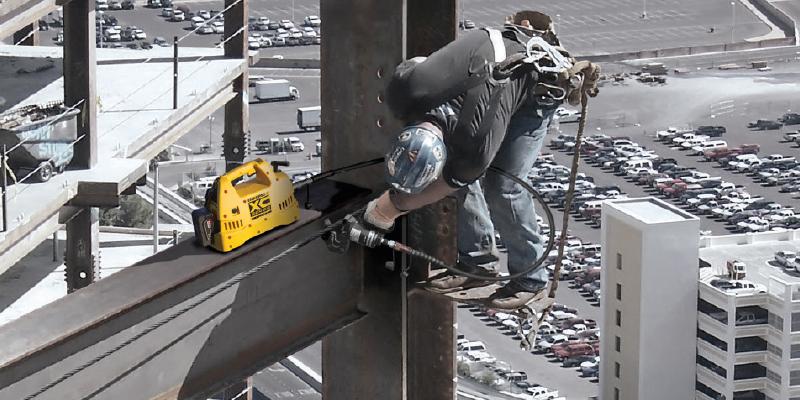The huge surge in new infrastructure development in Australasia – coupled with a rising wave of decommissionings and conversions of obsolete fossil fuel plant – will present an array of safety challenges and opportunities for industry in the years ahead.
Old manual methods of infrastructure construction and renewal will be replaced by new ways of exerting maximum force with minimal risk to workers, as we gratefully leave the age of flogging spanners and wasteful and unnecessary practices.
Companies now, conscious of their Duty of Care (and the awful cost of injuries and shutdowns), are embracing a whole new generation of powerful, portable and ergonomic tools that lighten the load while they increase the efficiency of operations such and bolting and unbolting, cutting, bending, lifting and forming.
Hydraulic battery technology, for example, has reached a point where cordless alternatives (such as hydraulic pumps) can now offer the same performance as their corded counterparts, with a sufficient fuel reservoir to last whole shifts without needing to replace or recharge the battery.
An additional bonus is that they can be used in locations where there’s limited or no access to power, such as remote sites, inaccessible machinery or high places where dragging around a cord around is not an option. Not to mention obviating the risk of electrocution.
In saying this, I should emphasise that for a myriad of applications, a corded tool is totally safe, and the ideal solution where the cords and power input are completely out of anyone’s way.
And for all clean, green electric tools – corded and cordless – increased safety is critical because of the huge personal and national costs of workplace accidents.
Following are some of the most common hazardous situations we seek solutions for by involving ergonomic, portable and cordless tools, or new technologies that replace manual inputs with time-saving and safer alternatives:
1. Slip and fall accidents, which are still too common to all sectors.
2. Repetitive strain injuries, in all industries, particularly where old equipment is manual and bulky.
3. Maintenance in confined spaces – especially mining energy and construction, but also inside heavy machinery (mobile and static).
4. Heavy lifting.
5. Emergency repairs in the field, to prevent downtime.
6. Rescue work, where powerful tools are needed immediately.
7. Airborne and remote sites work, where tools must be light and self-sufficient.
8. Sites where there is heavy wheeled traffic, such as forklifts in a factory or vehicles in a distribution centre.
9. Working at heights, particularly construction, but in plenty of other situations also, including mining loader booms, cranes and conveyors.
Carrying out bolting operations at height runs the risks of slip and fall accidents and the danger to those working beneath of dropped objects. Falls from height or being hit with moving or falling objects are among the major causes of death among the thousands of serious injuries to workers on construction and infrastructure projects.
Such hazards will also become a greater challenge in the energy industry as wind towers become more and more prevalent.
An example of lightweight power that can increase safety and portability in such situations is provided by the DSX series of five powerful compact aluminium square drive torque wrenches, each weighing from 2.2kg, to 32.5kg.
These particular tools – which complement our comprehensive range of controlled fastening technologies – address issues that can only expand as infrastructure construction gathers pace.
Cranes and conveyors
Another area where cordless tools are making safety inroads is in servicing of cranes and conveyors, without which industry ultimately cannot function.
OEM Techmine Solutions developed a new lightweight hydraulic belt lifter that utilises our XC-Series Cordless Portable Hydraulic Pump to safely and reliably provide the hydraulic pressure (700 bar, 10,000 PSI) required to lift belt sections up to 2,000kgs.
“The new belt lifter effortlessly raises the belt in 20 to 25 seconds without requiring complex input from the user. An 1800mm belt lifter, comprised of three main parts, weighs only 29.5 kilograms once assembled. The main 13.7 kilogram lifting beam is ergonomic and easily portable,” said Justen Wright, Principal Engineer, Techmine, and inventor of the new technology.
Safety Training
An essential component of using such powerful heavy lifting technology is having the appropriate safety training to ensure Standards compliance. Enerpac’s Goal Zero on-site safety training is designed to optimise the uptime and performance of widely used tools while spotlighting workplace hazards and preventable accidents.
These are practical, down-to-earth safety training development courses designed to deliver immediate benefits from course leaders who combine local expertise with global knowledge and standards. Key outcomes are reduced accidents and downtime.
Elements of the on-site courses are tailored to the needs of individual sites and workshops, including mine, oil and gas, energy generation, primary processing (including paper, sugar, food and beverage and agribusiness) bulk handling, construction, infrastructure (inc. ports and defence establishments) transport (inc. rail, road and aviation) and energy generation and public water and local authority service utility organisations. They include:
• Tool inspections and correct workplace usage guidance.
• Maintenance and storage practices that optimise safety and uptime.
• Spotlighting potentially dangerous practices, with case studies.
• Extending tool life and productivity.
• Safety guidelines for general situations and for particular industries.
• Attendance certificates.
And finally, farewell to flogging hammers
One of my final examples of practical, shop floor enterprise and innovation (which is often where good safety practice comes into effect) comes from an enterprising Queensland contracting company.
Gibson Instrumentation Services (GIS) developed a safer, faster and more cost-efficient way to assemble heavy ABON coal feeder chain links by replacing strenuous manual labour with compact and powerful hydraulic power. The 700 bar high-pressure hydraulic equipment is used to assemble the chain links to form ABON conveyors for extensive use in the mining and energy, coal, cement and aggregate industries.
GIS eliminated the need to use flogging tools during on-site assembly by a neatly portable combination comprising our C-clamp, 10-ton cylinder and lightweight PU series Electric Economy Pump with pendant control and pressure gauge for safety.
The new combination is used in ABON OEM work to precisely assemble chain lengths often weighing more than a ton, typically achieving tasks in one day that previously might have taken several. The Enerpac combination weighs less than half the 37kg of the previous customised tool that took two people to lift safely and required a crane for positioning.
The new tool is also light enough to be taken on-site for maintenance tasks, where it also increases the safety of the job and cuts the time taken to do it.
In conclusion
During the Covid pandemic we have all been forced to look at new ways of performing old tasks. Because we couldn’t have too many people together, there has been a spurt in the relevance of digital technologies (such as the EVO synchronous lifting technology). Technologies that enable us to do a better job, while removed from danger, are getting a real boost.
At the same time, the automotive transformation from fossil fuels to electric power has taken giant strides. Over the last decade a surge in lithium-ion battery production has led to an 85 percent decline in prices, making electric vehicles and energy storage commercially viable for the first time in history.
Battery-based safety tools have benefitted immensely. Once not regarded as a serious heavy-duty tool, they are now coming into their own as a mainstream safety product, benefitting both the environment generally, and their users particularly.
Details, Neville Stuart; Ph: 021 667 716; Email: neville@enerpac.co.nz
By Tony Cooper, Product Engineer and Asia-Pacific Marketing Manager, Enerpac






